We Asked ChatGPT: Is the AI Boom the New Dot Com Bubble?
By Doo Prime
 The short answer is not yet. But we’re getting closer.
The AI boom has been unstoppable. New chips, smarter models, and trillion-dollar valuations everywhere you look.
Investors are calling it “the next internet,” but history is flashing a warning: we’ve seen this before.
From soaring AI stocks to parabolic charts that echo the 1999 dot com bubble, the similarities are hard to ignore.
So, will this AI boom end with a quiet correction or a full-blown tech crash?
Let’s dig into the charts, the hype, and what voices like Bill Gates and Fed Chair Jerome Powell really think about today’s AI mania.
The AI Boom Feels Familiar
The rise of artificial intelligence stocks looks similar to the 1999 bubble.
Back then, the internet was “the future”. Today, it’s AI.
In both cases, investors poured billions into unproven business models.
Back then, it was websites. Now, it’s data centers, chips, and algorithms.
Still, not all hype ends the same way.
Unlike the dot com boom, today’s AI leaders such as Nvidia, Microsoft, AMD, Amazon, and Alphabet are profitable and cash-rich.
That’s a big difference from the 2000 bubble, when many firms didn’t even have revenue.
Could We Still See a Parabolic Move First?
Look at this chart.
The short answer is not yet. But we’re getting closer.
The AI boom has been unstoppable. New chips, smarter models, and trillion-dollar valuations everywhere you look.
Investors are calling it “the next internet,” but history is flashing a warning: we’ve seen this before.
From soaring AI stocks to parabolic charts that echo the 1999 dot com bubble, the similarities are hard to ignore.
So, will this AI boom end with a quiet correction or a full-blown tech crash?
Let’s dig into the charts, the hype, and what voices like Bill Gates and Fed Chair Jerome Powell really think about today’s AI mania.
The AI Boom Feels Familiar
The rise of artificial intelligence stocks looks similar to the 1999 bubble.
Back then, the internet was “the future”. Today, it’s AI.
In both cases, investors poured billions into unproven business models.
Back then, it was websites. Now, it’s data centers, chips, and algorithms.
Still, not all hype ends the same way.
Unlike the dot com boom, today’s AI leaders such as Nvidia, Microsoft, AMD, Amazon, and Alphabet are profitable and cash-rich.
That’s a big difference from the 2000 bubble, when many firms didn’t even have revenue.
Could We Still See a Parabolic Move First?
Look at this chart.
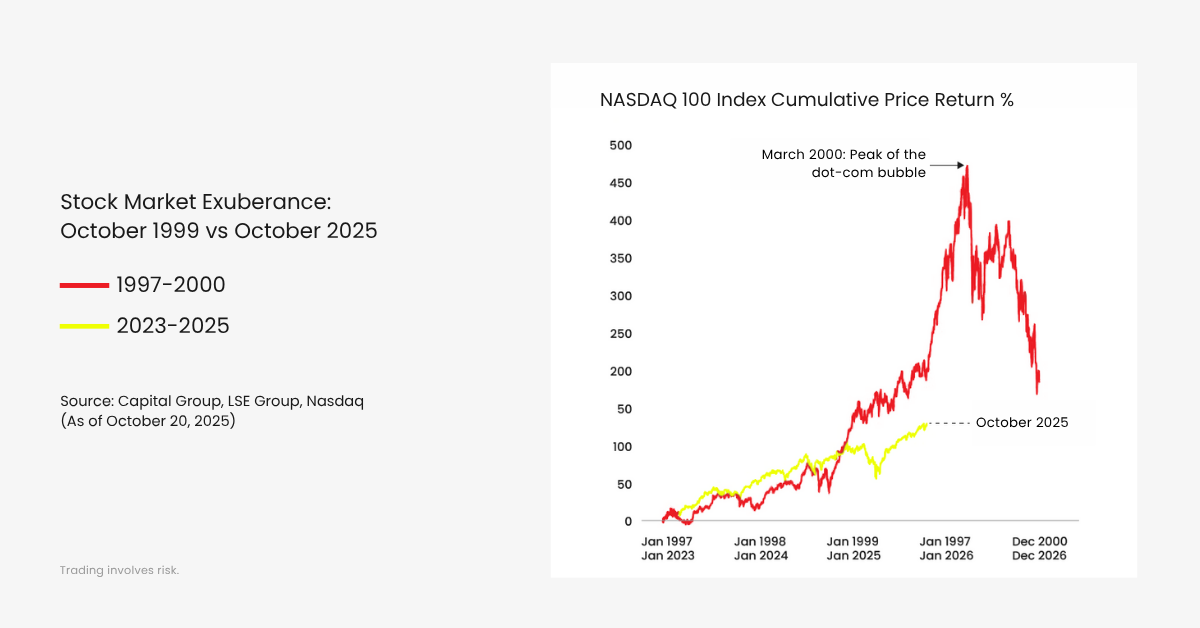 The current AI market rally still sits below the 2000 peak when compared to the dot com bubble.
That means we could see one huge parabolic move to the upside before a potential AI stock crash.
That’s exactly how the internet bubble behaved:
- Tech stocks doubled in the final months of 1999.
- Then, the tech crash erased 78% of the Nasdaq by late 2002.
So while we may not be at the top yet, the setup looks familiar. A melt-up before the unwind.
The Nasdaq vs. Dow Ratio: Déjà Vu of 2000
The Nasdaq-to-Dow ratio tells a clear story.
The current AI market rally still sits below the 2000 peak when compared to the dot com bubble.
That means we could see one huge parabolic move to the upside before a potential AI stock crash.
That’s exactly how the internet bubble behaved:
- Tech stocks doubled in the final months of 1999.
- Then, the tech crash erased 78% of the Nasdaq by late 2002.
So while we may not be at the top yet, the setup looks familiar. A melt-up before the unwind.
The Nasdaq vs. Dow Ratio: Déjà Vu of 2000
The Nasdaq-to-Dow ratio tells a clear story.
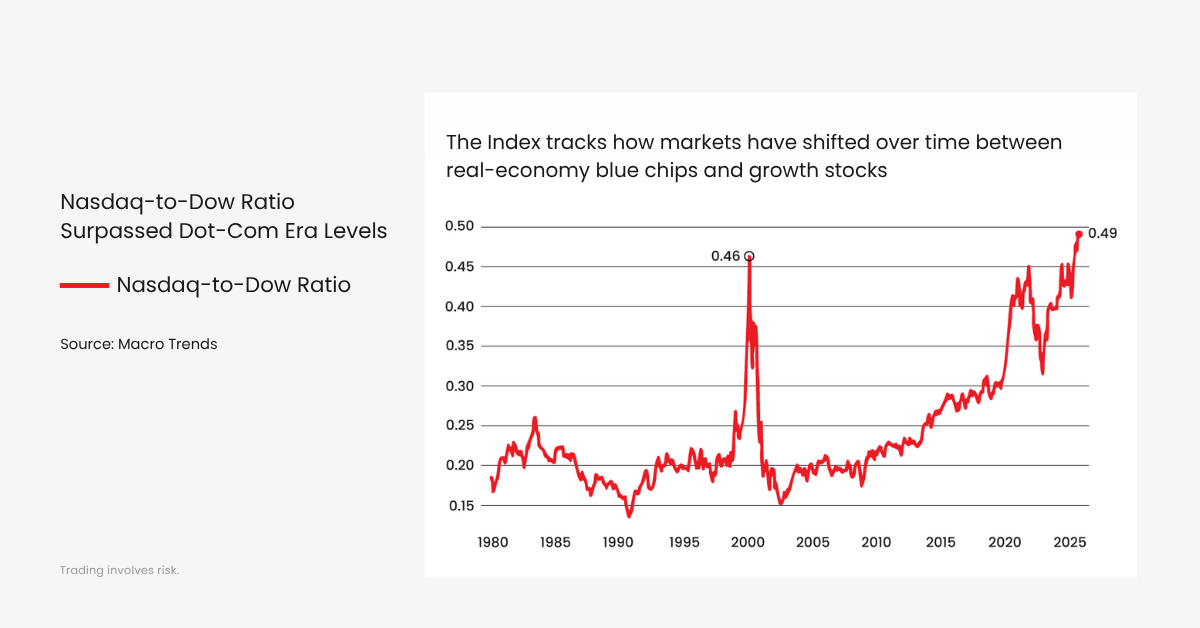 AI-driven tech stocks have massively outperformed industrial and financial names, just like during the dot com boom.
Whenever that ratio spikes this sharply, history shows a correction usually follows.
But again, there’s a nuance. The AI bubble is built on real infrastructure spending, not just dreams.
Cloud computing, AI data centers, and chip demand are creating tangible growth, not vaporware.
Still, investor concentration in the top AI stocks, mainly Nvidia, Microsoft, and AMD, could mean any slowdown hits fast and hard.
Bill Gates Warns of an Early AI Bubble
Even Bill Gates sees signs of a potential bubble forming.
In an interview this month, he said we’re in the “early stages of an AI bubble.”
His reasoning is that too many startups are chasing the same goal. They are building AI tools that might never turn a profit.
History says that when every company claims to be “AI-powered,” a shakeout usually follows.
But Gates also pointed out that this time, the winners will be enormous.
Just like Amazon and Google survived the dot com crash, a few best AI stocks could define the next decade.
In his words: “We’ll see failures, but the survivors will redefine everything.”
Powell Pushes Back: “AI Is Not a Bubble”
Federal Reserve Chair Jerome Powell disagrees.
He recently said AI is “not a bubble like the dot com era.”
His logic: productivity gains are measurable this time.
AI isn’t just hype, it’s driving real corporate investment, especially in automation, logistics, and software.
Powell’s view aligns with the Fed’s stance that the AI market boom is more structural than speculative.
In short: valuations are high, but fundamentals are stronger than 1999.
Still, bubbles often look rational right before they burst.
Why the AI Bubble Might Not Burst Yet
So, will the AI bubble burst?
Probably not right away.
History suggests that bubbles rarely die quietly.
They often end with a final blow-off phase, a euphoric rally before reality hits.
Right now, the market hasn’t shown that last phase yet.
Liquidity remains high, earnings from top artificial intelligence stocks are still growing, and retail FOMO hasn’t peaked.
In other words: the AI bubble burst may be coming, but the timing isn’t here yet.
We could see one more surge, especially if rate cuts arrive in 2025.
The Top AI Stocks Driving the Boom
If you pull up any AI stocks list, the same names dominate:
Nvidia, AMD, Microsoft, Alphabet, Amazon, and Meta.
Together, they make up a huge share of the S&P 500’s performance this year.
But that’s also the risk. If one cracks, the AI market crash could spread fast.
Investors are also piling into smaller Artificial Intelligence chipmakers and automation software companies, echoing the speculative wave of the dot com bubble.
Not all will survive.
How to Invest in Artificial Intelligence
If you’re wondering how to invest in artificial intelligence safely, think balance.
Instead of chasing parabolic moves, look for companies with real cash flow and product adoption.
Avoid overhyped names with little revenue, that’s where the bubble AI risk sits.
Diversification and patience matter more than timing the top.
As Gates hinted, the winners will likely become the next trillion-dollar giants.
But the road there will be volatile.
What Makes This Different from 1999
Despite the hype, there are crucial differences between now and the dot com bubble:
- Companies like Nvidia and Microsoft are profitable.
- AI adoption is already driving productivity.
- Global capital is more diversified.
Back in 1999, the internet was a promise.
Today, Artificial Intelligence is already an industry.
That doesn’t mean we’re safe. It just means the AI stock crash, if it comes, might look more like a rotation than a collapse.
Final Thoughts: A Bubble in Progress
So, is there an AI bubble?
Yes, but it’s still inflating.
Every revolution comes with speculation.
The 1999 bubble wiped out thousands of companies, yet it paved the way for trillion-dollar tech giants.
The Artificial Intelligence boom could do the same.
Some valuations will deflate, but innovation will outlast the noise.
We may be in the early innings of a bubble, not the end of one.
And if history repeats, the most painful corrections usually come after the biggest gains.
AI-driven tech stocks have massively outperformed industrial and financial names, just like during the dot com boom.
Whenever that ratio spikes this sharply, history shows a correction usually follows.
But again, there’s a nuance. The AI bubble is built on real infrastructure spending, not just dreams.
Cloud computing, AI data centers, and chip demand are creating tangible growth, not vaporware.
Still, investor concentration in the top AI stocks, mainly Nvidia, Microsoft, and AMD, could mean any slowdown hits fast and hard.
Bill Gates Warns of an Early AI Bubble
Even Bill Gates sees signs of a potential bubble forming.
In an interview this month, he said we’re in the “early stages of an AI bubble.”
His reasoning is that too many startups are chasing the same goal. They are building AI tools that might never turn a profit.
History says that when every company claims to be “AI-powered,” a shakeout usually follows.
But Gates also pointed out that this time, the winners will be enormous.
Just like Amazon and Google survived the dot com crash, a few best AI stocks could define the next decade.
In his words: “We’ll see failures, but the survivors will redefine everything.”
Powell Pushes Back: “AI Is Not a Bubble”
Federal Reserve Chair Jerome Powell disagrees.
He recently said AI is “not a bubble like the dot com era.”
His logic: productivity gains are measurable this time.
AI isn’t just hype, it’s driving real corporate investment, especially in automation, logistics, and software.
Powell’s view aligns with the Fed’s stance that the AI market boom is more structural than speculative.
In short: valuations are high, but fundamentals are stronger than 1999.
Still, bubbles often look rational right before they burst.
Why the AI Bubble Might Not Burst Yet
So, will the AI bubble burst?
Probably not right away.
History suggests that bubbles rarely die quietly.
They often end with a final blow-off phase, a euphoric rally before reality hits.
Right now, the market hasn’t shown that last phase yet.
Liquidity remains high, earnings from top artificial intelligence stocks are still growing, and retail FOMO hasn’t peaked.
In other words: the AI bubble burst may be coming, but the timing isn’t here yet.
We could see one more surge, especially if rate cuts arrive in 2025.
The Top AI Stocks Driving the Boom
If you pull up any AI stocks list, the same names dominate:
Nvidia, AMD, Microsoft, Alphabet, Amazon, and Meta.
Together, they make up a huge share of the S&P 500’s performance this year.
But that’s also the risk. If one cracks, the AI market crash could spread fast.
Investors are also piling into smaller Artificial Intelligence chipmakers and automation software companies, echoing the speculative wave of the dot com bubble.
Not all will survive.
How to Invest in Artificial Intelligence
If you’re wondering how to invest in artificial intelligence safely, think balance.
Instead of chasing parabolic moves, look for companies with real cash flow and product adoption.
Avoid overhyped names with little revenue, that’s where the bubble AI risk sits.
Diversification and patience matter more than timing the top.
As Gates hinted, the winners will likely become the next trillion-dollar giants.
But the road there will be volatile.
What Makes This Different from 1999
Despite the hype, there are crucial differences between now and the dot com bubble:
- Companies like Nvidia and Microsoft are profitable.
- AI adoption is already driving productivity.
- Global capital is more diversified.
Back in 1999, the internet was a promise.
Today, Artificial Intelligence is already an industry.
That doesn’t mean we’re safe. It just means the AI stock crash, if it comes, might look more like a rotation than a collapse.
Final Thoughts: A Bubble in Progress
So, is there an AI bubble?
Yes, but it’s still inflating.
Every revolution comes with speculation.
The 1999 bubble wiped out thousands of companies, yet it paved the way for trillion-dollar tech giants.
The Artificial Intelligence boom could do the same.
Some valuations will deflate, but innovation will outlast the noise.
We may be in the early innings of a bubble, not the end of one.
And if history repeats, the most painful corrections usually come after the biggest gains.US Stocks Hit Record Highs, S&P 500 Breaks 6,900
By Doo Prime
US stocks continued their record-setting streak on Tuesday, with all three major indexes closing higher for a third straight session.
Crypto Crash $19B: Is the Next Big Rebound Already Underway?
By Doo Prime
The crypto market just reminded everyone that volatility never really left.
19 billion US Dollars were wiped out in days as Bitcoin, Ethereum, and altcoins tumbled together, a full-blown crypto crash that sent traders scrambling and sentiment spiraling.
Gold Surges as Dollar Falls, Israel-Iran Tensions Lift Oil Prices
By Doo Prime
Gold prices surged nearly 2% on Tuesday as safe-haven demand returned amid a weaker US dollar and ongoing geopolitical tension. Spot gold ended the day up 1.84% at $3,289.98 per ounce. Oil prices, meanwhile, closed slightly lower as market uncertainty lingered.
Gold Falls Below $3,000, Oil Hit Lowest Since 2021
By Doo Prime
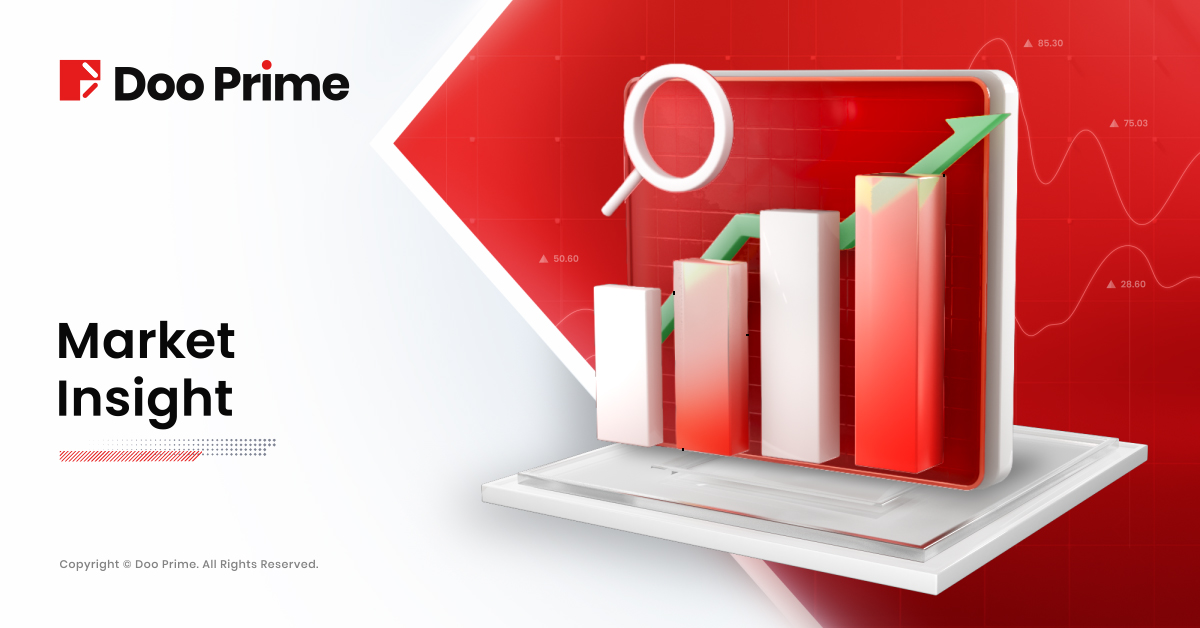 Monday Market Recap
Global markets saw major volatility on Monday, with gold experiencing an intraday swing of nearly $100. During the Asian session, it briefly surged past $3,050, but quickly reversed course, breaking below the $3,000 threshold and ending the day down for the third consecutive session. Spot gold closed at $2,982.55/oz.
Meanwhile, oil prices plunged to a three-year low, as investor concerns grew over US President Donald Trump’s latest tariffs potentially pushing the global economy into recession and curbing energy demand.
Gold Outlook
Gold saw intense fluctuations on Monday, with a nearly $100 swing. It briefly topped $3,050 in Asian trading before falling back and closing below the key $3,000 mark for the third day in a row. Spot gold dropped 1.85%, closing at $2,982.55/oz.
Tradu’s senior market analyst Nikos Tzabouras commented:
“In times of market turmoil, investors are shifting toward other safe-haven currencies like the dollar, Swiss franc, and yen. This has added pressure on gold and increased the risk of a deeper correction.”
The US dollar rose 0.53% against a basket of other currencies, marking its second straight day of gains and moving further from last week’s six-month low. A stronger dollar makes gold more expensive for holders of other currencies.
Trump’s new tariff policy has sparked renewed fears of a global economic slowdown. According to China’s Ministry of Commerce, the US has threatened to raise tariffs on Chinese goods by 50% as of April 7 (ET). China has firmly opposed the move and warned it will retaliate to protect its interests if the escalation goes into effect.
Interestingly, China’s central bank increased its gold reserves by 90,000 ounces in March, the fifth straight month of gold accumulation. Amid rising trade tensions, central bank buying could continue to bolster gold’s long-term strategic value.
Gold – Technical Outlook
After rebounding to $3,054 in the Asian session, gold faced resistance and trended lower throughout the European and US sessions. It eventually dropped below $2,960 to find support near $2,956 before a slight recovery. The daily candlestick closed as a bearish hanging man, reflecting strong intraday pressure. Overall, gold has been in a pullback for three sessions since reaching a high of $3,167 last week.
Monday Market Recap
Global markets saw major volatility on Monday, with gold experiencing an intraday swing of nearly $100. During the Asian session, it briefly surged past $3,050, but quickly reversed course, breaking below the $3,000 threshold and ending the day down for the third consecutive session. Spot gold closed at $2,982.55/oz.
Meanwhile, oil prices plunged to a three-year low, as investor concerns grew over US President Donald Trump’s latest tariffs potentially pushing the global economy into recession and curbing energy demand.
Gold Outlook
Gold saw intense fluctuations on Monday, with a nearly $100 swing. It briefly topped $3,050 in Asian trading before falling back and closing below the key $3,000 mark for the third day in a row. Spot gold dropped 1.85%, closing at $2,982.55/oz.
Tradu’s senior market analyst Nikos Tzabouras commented:
“In times of market turmoil, investors are shifting toward other safe-haven currencies like the dollar, Swiss franc, and yen. This has added pressure on gold and increased the risk of a deeper correction.”
The US dollar rose 0.53% against a basket of other currencies, marking its second straight day of gains and moving further from last week’s six-month low. A stronger dollar makes gold more expensive for holders of other currencies.
Trump’s new tariff policy has sparked renewed fears of a global economic slowdown. According to China’s Ministry of Commerce, the US has threatened to raise tariffs on Chinese goods by 50% as of April 7 (ET). China has firmly opposed the move and warned it will retaliate to protect its interests if the escalation goes into effect.
Interestingly, China’s central bank increased its gold reserves by 90,000 ounces in March, the fifth straight month of gold accumulation. Amid rising trade tensions, central bank buying could continue to bolster gold’s long-term strategic value.
Gold – Technical Outlook
After rebounding to $3,054 in the Asian session, gold faced resistance and trended lower throughout the European and US sessions. It eventually dropped below $2,960 to find support near $2,956 before a slight recovery. The daily candlestick closed as a bearish hanging man, reflecting strong intraday pressure. Overall, gold has been in a pullback for three sessions since reaching a high of $3,167 last week.
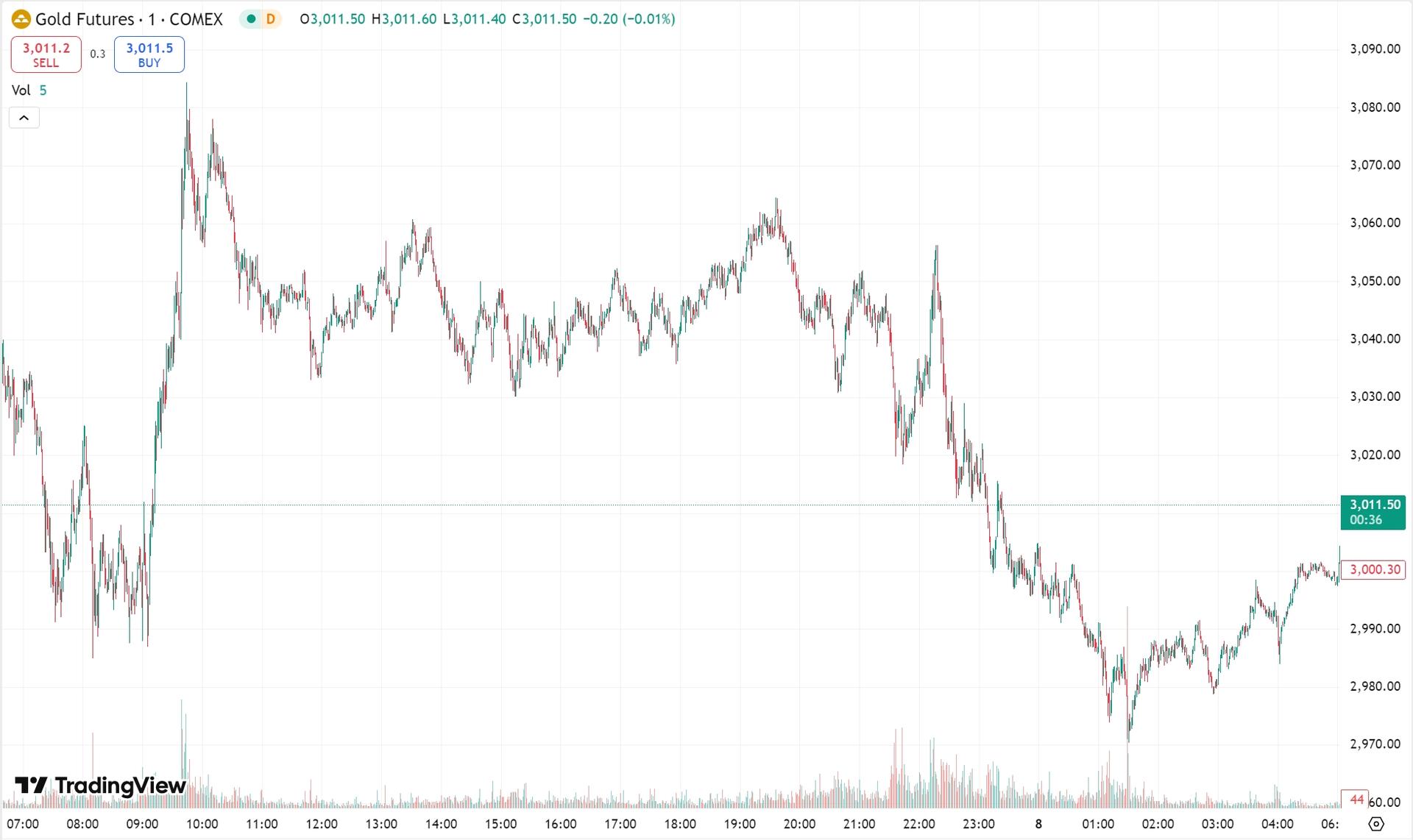 Gold – Today’s Focus
Strategy: Prefer short positions on rebounds, with selective long entries on pullbacks.
Key Resistance: $3,000 – $3,010
Key Support: $2,965 – $2,955
Oil Outlook
Oil prices also took a sharp hit on Monday. Fears that Trump’s latest tariffs could tip the global economy into recession and weaken energy demand dragged both WTI and Brent crude to their lowest levels since April 2021.
At the close:
WTI May Futures: fell $1.29 (–2.1%) to $60.70/barrel
Brent June Futures: dropped 2.09% to $64.21/barrel
During Monday’s session, crude briefly spiked by over $1 following a false report that Trump might pause tariffs for 90 days. The White House quickly denied the story, causing prices to reverse and resume their downward trend.
Investor concerns were further fueled after Saudi Aramco cut crude prices for Asian buyers. On April 6, the company lowered May’s official selling price for light crude to a $1.20 premium over the Oman/Dubai average, down from a $2.30 premium — the largest cut in over two years and the second consecutive month of price reductions.
Goldman Sachs also lowered its oil price forecasts, citing rising OPEC+ supply risks and the potential for a trade war-induced recession.
Brent 2024 forecast: down 5.5% to $69/barrel
WTI 2024 forecast: down 4.3% to $66/barrel
Brent 2026 forecast: down 9% to $62/barrel
WTI 2026 forecast: down 6.3% to $59/barrel
The bank also warned of further potential downgrades.
Oil – Technical Outlook
Oil declined in both the Asian and European sessions, briefly dipping below $59 before rebounding. In the US session, it spiked to $63.80 but couldn’t hold the gains and fell back to around $61 by the close. The daily candlestick formed a doji, signaling indecision but still within a broader bearish trend.
Gold – Today’s Focus
Strategy: Prefer short positions on rebounds, with selective long entries on pullbacks.
Key Resistance: $3,000 – $3,010
Key Support: $2,965 – $2,955
Oil Outlook
Oil prices also took a sharp hit on Monday. Fears that Trump’s latest tariffs could tip the global economy into recession and weaken energy demand dragged both WTI and Brent crude to their lowest levels since April 2021.
At the close:
WTI May Futures: fell $1.29 (–2.1%) to $60.70/barrel
Brent June Futures: dropped 2.09% to $64.21/barrel
During Monday’s session, crude briefly spiked by over $1 following a false report that Trump might pause tariffs for 90 days. The White House quickly denied the story, causing prices to reverse and resume their downward trend.
Investor concerns were further fueled after Saudi Aramco cut crude prices for Asian buyers. On April 6, the company lowered May’s official selling price for light crude to a $1.20 premium over the Oman/Dubai average, down from a $2.30 premium — the largest cut in over two years and the second consecutive month of price reductions.
Goldman Sachs also lowered its oil price forecasts, citing rising OPEC+ supply risks and the potential for a trade war-induced recession.
Brent 2024 forecast: down 5.5% to $69/barrel
WTI 2024 forecast: down 4.3% to $66/barrel
Brent 2026 forecast: down 9% to $62/barrel
WTI 2026 forecast: down 6.3% to $59/barrel
The bank also warned of further potential downgrades.
Oil – Technical Outlook
Oil declined in both the Asian and European sessions, briefly dipping below $59 before rebounding. In the US session, it spiked to $63.80 but couldn’t hold the gains and fell back to around $61 by the close. The daily candlestick formed a doji, signaling indecision but still within a broader bearish trend.
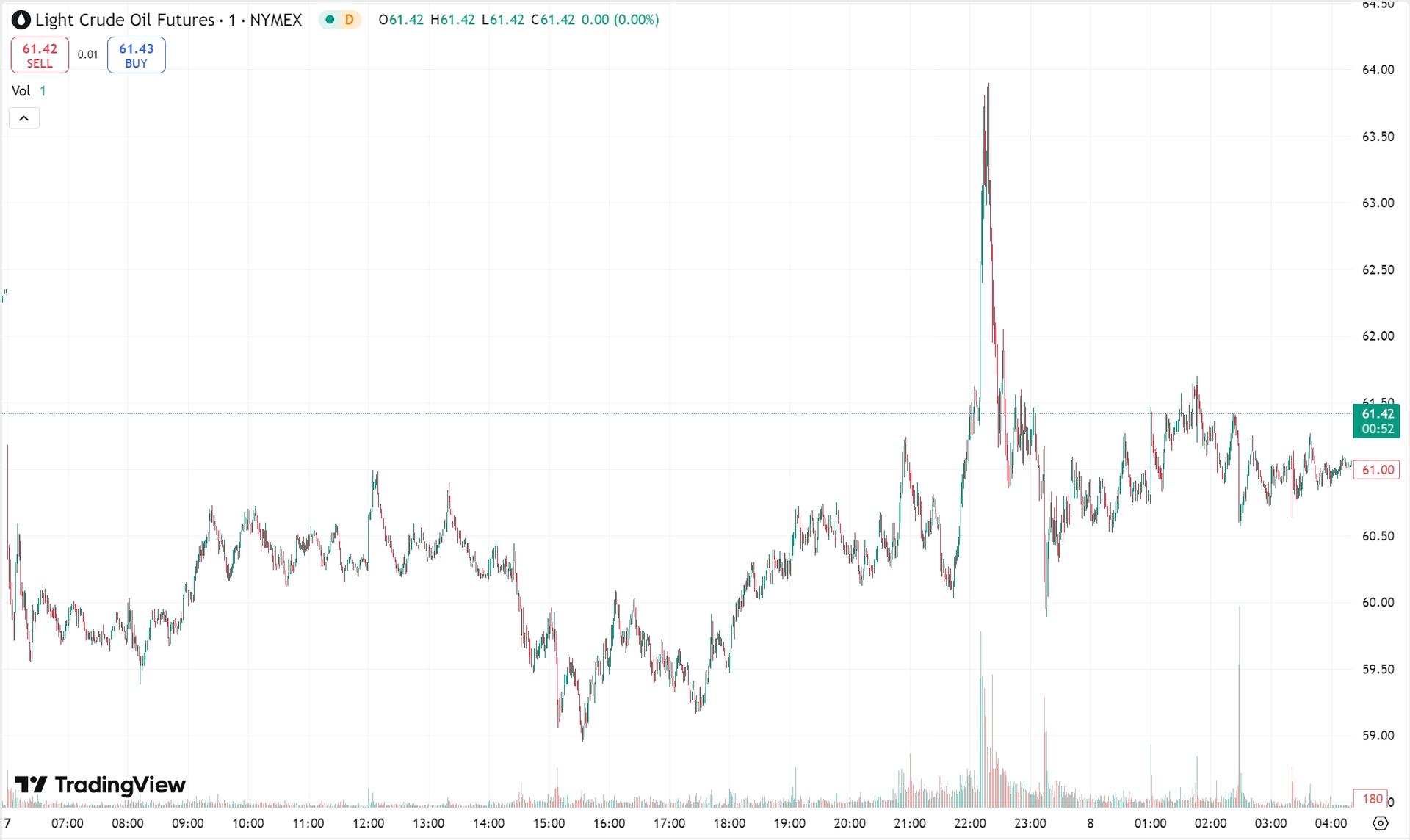 Oil – Today’s Focus
Strategy: Favor short positions on rebounds, with limited long positions on dips.
Key Resistance: $63.0 – $64.0
Key Support: $60.0 – $59.0
Oil – Today’s Focus
Strategy: Favor short positions on rebounds, with limited long positions on dips.
Key Resistance: $63.0 – $64.0
Key Support: $60.0 – $59.0US Stocks Hit 5-Year Low, Nikkei Drops Below 34,000
By Doo Prime
On Friday, global financial markets were rocked by a sharp sell-off after US President Trump announced a large-scale tariff plan. The three major US stock indices plummeted, marking their biggest single-day percentage losses in years. Following the overnight decline in US stocks, Asian-Pacific markets also opened lower and continued to trend downward.
Gold Surges to New Intraday Record, Oil Climbs 2%
By Doo Prime
Gold briefly surged to a new all-time high of $3,057.25 during Asian trading on Thursday before retreating slightly to close at $3,044.73 per ounce. The rally was driven by heightened expectations of a Fed rate cut, after President Donald Trump publicly called on the central bank to act. Meanwhile, crude oil prices climbed nearly 2%, buoyed by OPEC+ compensation cuts and new US sanctions on Iran.
Gold Dips as Equities Plunge; Oil Hit by Demand Fears
By Doo Prime
Gold retreated sharply as profit-taking surged following a broad stock market sell-off. Prices briefly hit a one-week low of $2,880.19 per ounce before closing at $2,889.33, falling below the key $2,900 level. Meanwhile, oil prices declined more than 1% as concerns grew over US trade policies slowing global economic growth and dampening energy demand.
Gold Strengthens on Market Turmoil; Oil Sinks to Three-Month Low
By Doo Prime
Gold Overview
On Tuesday, gold extended its rally as escalating trade tensions following President Trump’s new tariffs weakened the US dollar, boosting safe-haven demand. Spot gold closed 0.83% higher at $2,917.64 per ounce.

